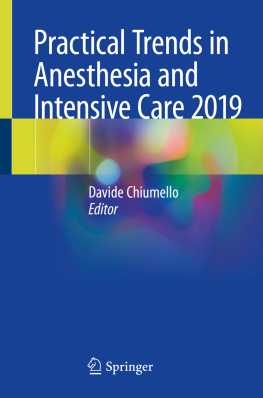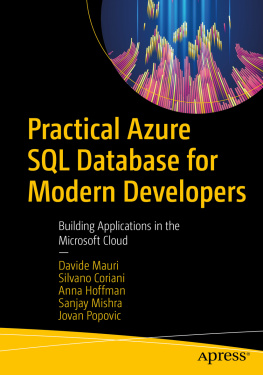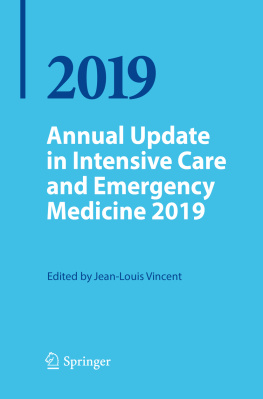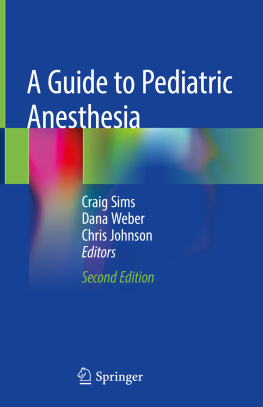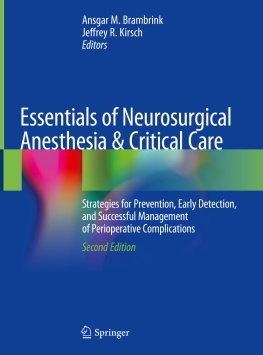Davide Chiumello - Practical Trends in Anesthesia and Intensive Care 2019
Here you can read online Davide Chiumello - Practical Trends in Anesthesia and Intensive Care 2019 full text of the book (entire story) in english for free. Download pdf and epub, get meaning, cover and reviews about this ebook. year: 2020, publisher: Springer International Publishing, genre: Home and family. Description of the work, (preface) as well as reviews are available. Best literature library LitArk.com created for fans of good reading and offers a wide selection of genres:
Romance novel
Science fiction
Adventure
Detective
Science
History
Home and family
Prose
Art
Politics
Computer
Non-fiction
Religion
Business
Children
Humor
Choose a favorite category and find really read worthwhile books. Enjoy immersion in the world of imagination, feel the emotions of the characters or learn something new for yourself, make an fascinating discovery.
- Book:Practical Trends in Anesthesia and Intensive Care 2019
- Author:
- Publisher:Springer International Publishing
- Genre:
- Year:2020
- Rating:5 / 5
- Favourites:Add to favourites
- Your mark:
- 100
- 1
- 2
- 3
- 4
- 5
Practical Trends in Anesthesia and Intensive Care 2019: summary, description and annotation
We offer to read an annotation, description, summary or preface (depends on what the author of the book "Practical Trends in Anesthesia and Intensive Care 2019" wrote himself). If you haven't found the necessary information about the book — write in the comments, we will try to find it.
Practical Trends in Anesthesia and Intensive Care 2019 — read online for free the complete book (whole text) full work
Below is the text of the book, divided by pages. System saving the place of the last page read, allows you to conveniently read the book "Practical Trends in Anesthesia and Intensive Care 2019" online for free, without having to search again every time where you left off. Put a bookmark, and you can go to the page where you finished reading at any time.
Font size:
Interval:
Bookmark:
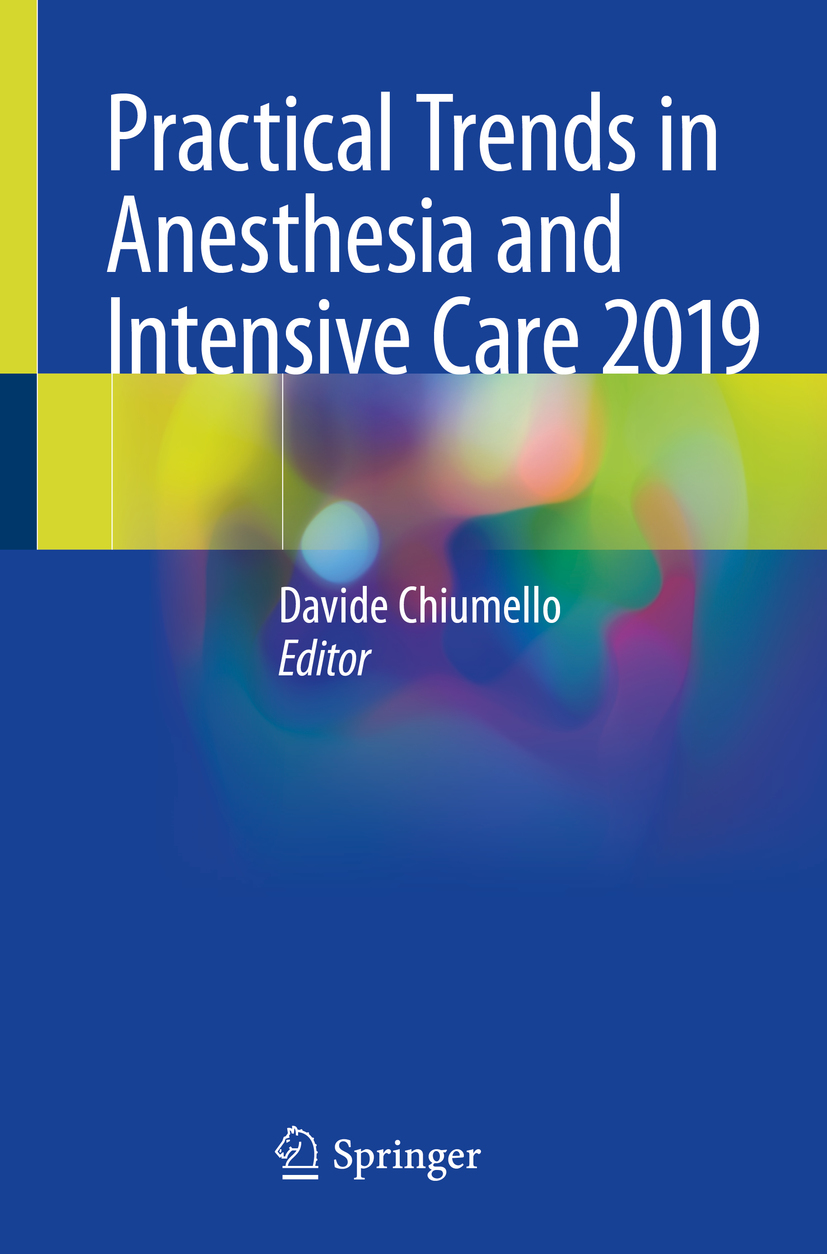

This Springer imprint is published by the registered company Springer Nature Switzerland AG
The registered company address is: Gewerbestrasse 11, 6330 Cham, Switzerland
In most patients, weaning from mechanical ventilation can occur as soon as the cause of respiratory failure is resolved, but about 2030% of patients are considered difficult to wean [], extubation failure causes an increase in length of stay in hospital and intensive care unit and is associated with an increase in mortality.
As noted by several authors [], previous respiratory disease, previous cardiac disease, and old age are predictors of weaning failure, and we should give these patients special attention.
The pathophysiology of weaning failure is complex and requires a systematic differential diagnostic approach to identify the primary cause of weaning failure, and this can improve the possibilities to overcome a new SBT. Weaning failure may be due to impaired respiratory mechanics, respiratory muscle dysfunction, cardiac dysfunction, cognitive dysfunction, and metabolic disorders [].
The transition from positive inspiratory pressure during mechanical ventilation to negative airway pressure during spontaneous breathing tests the patients physiological reserve. Weaning fails when the ventilatory needs of the patient overcome the ventilatory capacity.
Lungs and heart are functionally and anatomically coupled, so the transition from mechanical ventilation to spontaneous breathing leads to profound cardiovascular effects that could be the underlying reason for the weaning failure.
During mechanical ventilation with positive airway pressure, the intrathoracic pressure rises during inspiration, while during spontaneous breathing, the intrathoracic pressure becomes negative due to the activation of the inspiratory muscles. This pressure drop during the weaning trial suddenly increases venous return and increases left ventricle afterload.
In addition, there is an increase in the sympathetic tone related to stress (documented by the increase in serum catecholamine levels), hypercapnia, and hypoxemia, which could further increase left ventricle afterload. There is an increase in the heart oxygen demand and an increase in the respiratory muscle oxygen demand. There is also an increase in work of breathing (WOB).

Mechanisms involved in weaning-induced pulmonary oedema
It is clear that spontaneous breathing should be considered an intense physical exercise []. Numerous studies have documented that the transition from mechanical ventilation to spontaneous breathing induces an increase of stress for the heart that can induce myocardial ischemia in patients with coronary artery disease (CAD). However, even in the absence of coronary artery disease, inspiratory efforts can alter the diastolic function of the left ventricle with impaired relaxation, reduced compliance, and increased filling pressures, leading to cardiogenic pulmonary edema with resulting respiratory failure.
It is therefore essential that clinicians are aware that the transition to spontaneous breathing is an intense physical exercise, which can put the heart in a situation of excessive workload, with increased myocardial oxygen demand and consumption, induce myocardial ischemia, or promote heart failure [].
It is a common experience to find patients in the intensive care unit who may need mechanical ventilation for a strictly cardiological reason, such as an acute heart failure, or we may find ourselves in front of a cardiac patient who needs mechanical ventilation for a different reason, such as trauma or surgery and considering the role of the heart in the weaning process is fundamental.
Font size:
Interval:
Bookmark:
Similar books «Practical Trends in Anesthesia and Intensive Care 2019»
Look at similar books to Practical Trends in Anesthesia and Intensive Care 2019. We have selected literature similar in name and meaning in the hope of providing readers with more options to find new, interesting, not yet read works.
Discussion, reviews of the book Practical Trends in Anesthesia and Intensive Care 2019 and just readers' own opinions. Leave your comments, write what you think about the work, its meaning or the main characters. Specify what exactly you liked and what you didn't like, and why you think so.

